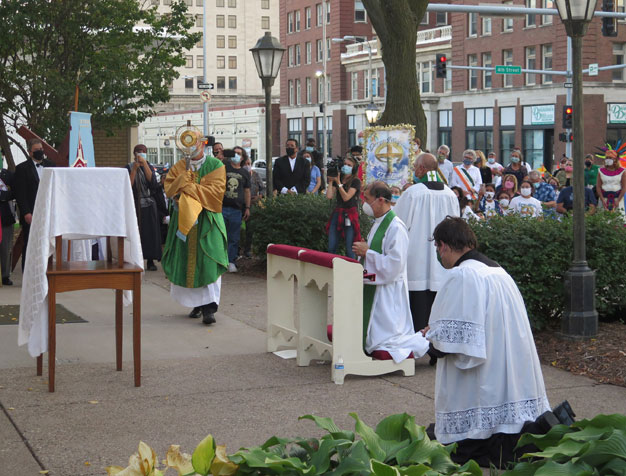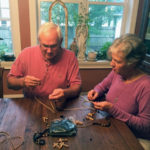
Bishop Thomas Zinkula carries the monstrance during benediction outside St. Anthony Church Oct. 11. St. Mary and St. Anthony parishes merged July 1.
(This is the first in an ongoing series on planning for the future of our local church.)
By Barb Arland-Fye
The Catholic Messenger
Parishes around the Diocese of Davenport, especially those in three largely urban areas — Clinton, Johnson and Scott counties — can expect more collaboration, clustering and merging in the years ahead. The declining participation of Catholics and the shrinking number of priests available to serve them makes change a reality.
That sobering news greeted parish leaders during the annual Parish Corporate Board meetings conducted over Zoom video conference Oct. 11 and 13. However, diocesan leaders say Catholics can reverse the trend by taking proactive steps to boost participation in parishes and inspire vocations to the priesthood, diaconate, lay ministry and religious life. The launch of a Vision 20/20 initiative of small group faith sharing called the “Emmaus Initiative” could be the first step in building community and journeying toward vitality.
Dan Ebener, diocesan director of Parish Planning, laid out the present situation and projections for a decade from now in a PowerPoint presentation developed with Bishop Thomas Zinkula, Vicar General Father Thom Hennen, and Chief of Staff Deacon David Montgomery.
Aging priests
By July 1 of next year, 12 of the current 55 active diocesan priests will be 70 years or older, the age at which a priest may retire. Some priests continue in active ministry for a few more years after they reach the age of 70. Of the other 43 active priests, 21 (almost half) will turn 70 years or older during the next 10 years. By 2030, 33 of the 55 priests active today will be 70 years or older. Just 22 of the active priests today (40%) will be under the age of 70 a decade from now.
In 10 years, the diocese projects that a few active priests will be serving full-time in non-parish ministries; and a handful might be considered newly ordained. “That would add up to 26 priests to work in 76 parishes — about three parishes per priest — if we keep that same number of parishes,” Ebener said. The diocese anticipates ordinations to the priesthood over the next 10 years, but not at a pace to keep up with retirements from active ministry. International priests also are a possibility, but not the total solution, the bishop said.
Vocations are in decline not only for priestly life, but also to the diaconate and religious life, according to diocesan records. Many cultural factors contribute to the downturn, resulting in decreased Mass attendance and sacramental participation. “This is the reason for Vision 20/20: To strengthen discipleship, families and parishes — make them more vibrant and alive.This naturally will lead to more vocations and more priests,” Ebener said.
A sense of urgency remains. “We can’t project (priests’) health, we can’t project necessarily Catholic participation and how that might change. However, one thing we can project out is the age of our priests. When I started looking at the numbers, you can see there’s a pretty dramatic effect in the next 10 years,” Ebener told The Catholic Messenger. “The next four to six years we’re pretty certain we’re going to have some difficulties with staffing all of our parishes with the number of priests that we’re used to.”
Collaboration
“We’re talking primarily about ways to either merge, which is the greatest form of collaboration,” Ebener said, or to “cluster, which is a kind of middle-ground level of collaboration.” Another option is collaboration among parishes that are not clustered, “for example working within their local area planning groups to hire a youth minister together or plan a Lenten retreat together, or those kinds of things. We would like to see more of that first level form of collaboration happen. However, experience shows that it is more likely to happen once they all have the same pastor.”
The various forms of collaboration “depend on the pastor, and his gifts and his interest in bringing people together,” Bishop Zinkula said. “They depend on the people (of the parish), the culture and history and the physical distance between parishes. Nonetheless, we have to work together more throughout the diocese.”
Change will focus on Clinton, Johnson and Scott counties specifically because of the current concentration of priests there. When diocesan leaders meet with priests in the six deaneries (geographical areas) of the diocese, “priests will tell you that we’ve done more restructuring in the rural areas than needed and we haven’t done as much in the urban area as needed,” Ebener said. “We hear from the priests that we need to focus more on the urban areas.”
Focus has moved to action with the merger of St. Mary and St. Anthony parishes in Davenport this past summer. The Bettendorf Catholic community — Our Lady of Lourdes and St. John Vianney — are in the midst of exploring collaboration models.
Parishes have been merging, clustering and collaborating for many years, said Bishop Zinkula, a priest of 30 years. People are beginning to understand these collaborative concepts but need to be educated about today’s reality and respond to it proactively.
Fostering vitality
In previous planning initiatives, diocesan leaders looked at parishes through the lens of viability, which Ebener described as a minimalist approach. Vitality emphasizes a thriving parish community in which Catholics are engaged and living as missionary disciples.
“That’s our faith, giving ourselves away to others, sharing our gifts and talents as we walk with one another. The more parishioners and parishes work together and share resources … where two or three are gathered in my name … the more those parishes have vitality,” Bishop Zinkula said.
Think Vision 20/20. “We have a good thing going here,” Bishop Zinkula said. “The Holy Spirit is present and we can tap into the Spirit. But God also expects us to do our part.”
The ingredients to ‘Grow our church’
• Take faith more seriously.
• Become more faithful disciples of Jesus Christ.
• Evangelize. Get involved with Vision 20/20 and the Emmaus Initiative. Register at davenportdiocese. org/emmaus
• Work to make your parish stronger and holier.
• Pray and work for vocations.
• Personally invite others to Mass.
• Create a Christian community rooted in Christ and family relationships.











